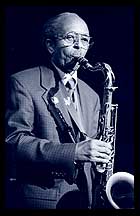
|
|
|
|
|
|
Photo Credit: Tim Owens |
Jimmy Heath
Jazz history boasts a number of families of prominent musicians. Standout saxophonist and composer Jimmy Heath hails from one of the most distinguished families in jazz, the Heaths of Philadelphia via North Carolina. Jimmy, the middle brother of bassist Percy Heath and drummer Albert Heath, joins Dr. Taylor for this edition of Billy Taylor’s Jazz at the Kennedy Center. A gregarious sort with a wry sense of humor to match his superb saxophone playing, Heath is greeted by another enthusiastic audience at the Kennedy Center. Jimmy Heath began his saxophone exploits on the alto saxophone in the 1940s. He acquired the nickname "Little Bird" because his alto playing bore a resemblance to that of the reigning master, Charlie "Yardbird" Parker. But after switching to the tenor saxophone, Heath developed and mastered his own unique style, as Dr. Taylor is quick to point out. Jimmy’s wonderful tenor sound has graced many a bandstand, but his family collaboration, known as the Heath Brothers, has given him the greatest satisfaction. The Heath family ties run deep, as Jimmy explains to Dr. Taylor. Billy engages Heath in an enlightening discussion on his training and development of his own style. In particular, they discuss how Heath's study of various musical systems, including the Schillinger system, which breaks music down numerically. During the show, Jimmy fields several interesting questions from audience members. This evening's delightful inquisition begins with a question on the overall importance of jazz education. A jazz educator himself, Heath takes on the questions with great relish, noting the importance of musical training to those who do not make it their vocation. Among Heath's formative bandstand associations was a stint in Dizzy Gillespie's storied bebop big band. Gillespie helped pioneer the bebop style, which developed in the 1940s and marked the advent of modern jazz. Typically, bebop was characterized by smaller combos – in contrast with the big band ensembles of swing, its stylistic predecessor. Heath was a featured soloist in Gillespie's genre-defying big band, and attained widespread exposure. Jimmy talks in glowing terms about the training he received from Gillespie and his chief arranger, Gil Fuller. Heath considers the experience essential to his development.
Throughout the program, a palpable presence of the tenor saxophone’s jazz legacy fills the air. Fittingly, an audience member asks about Jimmy's close friendship with the great tenor saxophonist John Coltrane. Laughing with the audience, Heath remarks that Coltrane was '99% pure music' in his dogmatic pursuit of mastery. Along with a steady dose of Heath's wonderful sound on the sax, the audience is treated to his original
compositions, including "Ellington's Stray Horn," a piece he wrote to honor Duke Ellington and Billy Strayhorn's unique writing partnership.
|
|
| |
